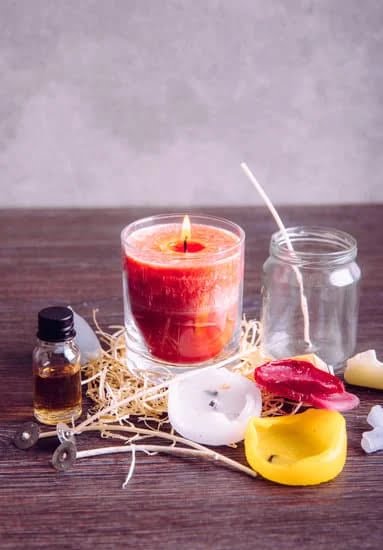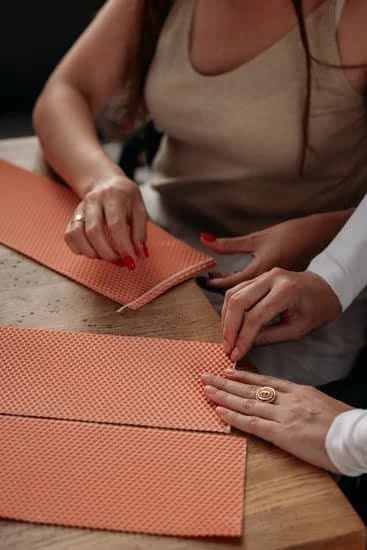Candle making has long been enjoyed as a hobby and art form, but did you know that the process of creating your own candles can also have calming effects? In this article, we will explore the art of candle making and its ability to promote relaxation and tranquility.
From the history of candle making to the science of aromatherapy, we will delve into the various aspects of this craft and how it can contribute to a sense of calm in your daily life. Whether you are a beginner or an experienced crafter, there is something truly soothing about the process of creating your own To Be Calm candles.
The history of candle making dates back thousands of years, with its origins rooted in ancient civilizations. Throughout time, candle making has evolved from simple tallow-based candles to the wide range of wax options available today. Understanding this history not only adds depth to the craft, but also highlights its enduring appeal as a source of relaxation.
In addition to its historical significance, scented candles have gained popularity for their psychological and emotional benefits. Aromatherapy, which harnesses the power of scent to promote well-being, plays a significant role in candle making. By choosing specific fragrances and essential oils, you can create candles that cater to your individual needs for calmness and serenity. In the following sections, we will further explore how scented candles can contribute to a peaceful and tranquil environment in your home or workspace.
The History of Candle Making
Candle making has a long and fascinating history that dates back to ancient times. From the early Egyptians using rushlights made from reeds dipped in animal fat to the Romans creating candles from tallow, this art form has evolved significantly over the centuries. The history of candle making is a testament to human innovation and creativity, as well as a reflection of the role that candles have played in various cultures and societies around the world.
Origins of Candle Making
The origins of candle making can be traced back to as early as 200 BC, when tallow candles were first created by the Ancient Romans. These early candles were made by pouring melted animal fat or tallow into a mold with a wick inserted in the center. Tallow candles remained popular for centuries due to their affordability and accessibility, although their unpleasant odor and poor quality led to the development of more refined candle-making methods.
Evolution of Candle Making Techniques
Over time, candle making techniques evolved, leading to the use of beeswax as a more luxurious alternative to tallow. Beeswax candles became highly prized for their clean, slow-burning properties and pleasant aroma. In the Middle Ages, candle making became an established trade, with chandlers – skilled artisans who specialized in crafting candles – producing high-quality wax candles for churches and wealthy households.
As society progressed, new materials such as spermaceti wax extracted from sperm whales and paraffin derived from petroleum were introduced. The industrial revolution further revolutionized candle production with the introduction of mechanized candle-making equipment, making it easier and more efficient to produce large quantities of candles.
Today, while traditional methods of hand-dipping and molding candles still exist, modern innovations have expanded the range of materials and techniques available for creating unique and personalized candles. Whether using soy wax or essential oils for fragrance, contemporary candle makers continue to build on the rich history of this timeless craft while embracing new opportunities for creative expression.
The Science of Aromatherapy
Scented candles have been used for centuries to enhance mental, physical, and spiritual well-being. The use of aromatherapy dates back to ancient civilizations such as the Egyptians, who were known for using aromatic plant extracts for medicinal and cosmetic purposes. The practice of using scented candles for their therapeutic properties has since evolved into a popular form of alternative medicine, known for its ability to promote relaxation, improve mood, and reduce stress.
Aromatherapy works by stimulating the olfactory system, which is the part of the brain connected to smell. When the scent of a candle is inhaled, it can trigger a response in the brain that can have various effects on the body.
For example, certain scents like lavender and chamomile are known for their calming properties and can help reduce anxiety and promote better sleep. On the other hand, citrus scents like lemon and orange are invigorating and can help improve focus and concentration.
In addition to their psychological benefits, scented candles can also have an emotional impact on individuals. For instance, studies have shown that certain fragrances can evoke specific memories or emotions. This is why many people associate certain scents with positive experiences or feelings of comfort and security. As a result, using scented candles in a calming environment can contribute to an overall sense of well-being and relaxation.
| Aromatherapy Benefit | Example Scent |
|---|---|
| Calming | Lavender |
| Uplifting | Citrus (lemon or orange) |
Essential Tools and Materials
Candle making is a soothing and meditative craft that can bring a sense of calm and relaxation to the maker. Before you embark on your candle making journey, it’s essential to gather all the necessary tools and materials to ensure a successful and enjoyable experience. Here is a comprehensive guide to the supplies needed for candle making:
- Wax: The foundation of any candle, you can choose from various types such as soy wax, beeswax, paraffin wax, or coconut wax. Each type has its own unique properties and benefits, so it’s important to select one that aligns with your preferences and needs.
- Wicks: The wick is what allows the candle to burn and requires careful consideration. Choose a wick size appropriate for the diameter of your candle and consider using eco-friendly cotton wicks for a sustainable option.
- Fragrances: To elevate the calming effects of your candle, consider adding essential oils or fragrance oils. Popular choices include lavender, vanilla, sandalwood, and citrus scents, each renowned for their relaxation-inducing properties.
- Colorants: If you want to add visual appeal to your candles, consider using dye chips or liquid dyes to create vibrant and eye-catching colors.
- Containers: Depending on your preference, you can use jars, tins, or molds as containers for your candles. Make sure they are heat-safe and suitable for holding melted wax.
- Thermometer: A crucial tool for monitoring the temperature of the melted wax to ensure it doesn’t overheat or cool too quickly.
As you begin gathering these essential tools and materials for your candle making endeavor, keep in mind that quality ingredients will contribute to a higher-quality final product. By investing in high-grade supplies and paying attention to detail throughout the process, you can create To Be Calm candles that not only induce relaxation but also fill your space with delightful aromas.
Whether you’re an experienced crafter or just starting out in the world of candle making, having a well-stocked supply kit will set you up for success in creating beautiful and calming candles that bring joy and tranquility into your life.
Step-by-Step Guide to Candle Making
Choosing the Right Wax
The first step in making your own calming candles is to choose the right wax. There are several options available, including paraffin wax, soy wax, and beeswax. Each type of wax has its own unique qualities, so it’s important to consider factors such as burn time, scent throw, and eco-friendliness when making your selection.
Adding Fragrances and Colors
Once you have chosen the right wax for your calming candle, it’s time to add fragrances and colors. Essential oils are a popular choice for adding scents to candles, as they offer a natural and therapeutic aroma. When adding colors, make sure to use dyes that are specifically designed for candle making to ensure that they will blend evenly with the wax.
Creating Your Candle
After choosing the right wax and enhancing it with fragrances and colors, it’s time to create your calming candle. This involves melting the wax, adding the fragrance and color, and pouring the mixture into a container or mold. It’s important to follow proper safety precautions during this process to avoid any accidents.
By following this step-by-step guide to candle making, you can craft your very own calming candles that not only look beautiful but also provide a sense of relaxation and tranquility when lit. Whether you’re making them for yourself or as gifts for loved ones, the process of creating these soothing candles can be both fulfilling and enjoyable.
Safety Precautions
When engaging in the art of To Be Calm candle making, safety should be a top priority to ensure a hassle-free and enjoyable experience. Working with hot wax, potent fragrances, and open flames requires careful attention to detail and adherence to safety precautions. By following these important tips, you can create your calming candles without any accidents or mishaps.
First and foremost, always work in a well-ventilated area when making candles. This will help to disperse any potentially harmful fumes from the melting wax and fragrance oils. Additionally, it’s essential to have a clean and clutter-free workspace to minimize the risk of spills or accidents. Keep flammable materials away from your work area, and never leave melting wax unattended.
Another crucial safety precaution is using appropriate equipment when handling hot wax. Invest in a quality double boiler or dedicated wax melter to melt your wax safely. Avoid direct heat sources such as stovetops or microwaves, as they can pose fire hazards. When pouring hot wax into containers, be sure to use heat-resistant vessels that are designed for candle making.
Finally, always keep a fire extinguisher within reach in case of emergencies. Accidents can happen even with the utmost care, so being prepared with a fire extinguisher is crucial for ensuring a safe candle making experience. By following these safety precautions, you can enjoy the process of creating your own To Be Calm candles without any worries about potential hazards.
Customizing Your Calming Candle
When it comes to candle making, the possibilities for customization are endless. From choosing the perfect scent to creating a unique appearance, customizing your calming candle can be a truly rewarding experience. Here are some tips for personalizing your candle’s scent and appearance:
Choosing the Right Scent
- Consider the mood you want to create: Whether you’re looking for a calming, uplifting, or energizing atmosphere, there’s a scent that suits every mood. Lavender is known for its calming properties, while citrus scents can uplift and invigorate.
- Experiment with essential oils: Essential oils offer a wide range of aromatherapy benefits. Consider blending different oils to create a custom scent that appeals to your senses and provides the desired calming effect.
- Take allergies into account: Some individuals may have sensitivities to certain scents. It’s important to consider potential allergies when selecting the fragrance for your calming candle.
Creating a Unique Appearance
- Explore different wax types: From traditional paraffin wax to natural soy wax, there are various options available for creating candles with different textures and colors.
- Add visual interest with layers or swirls: Experimenting with layering different colored waxes or creating swirl patterns can add a visually appealing touch to your calming candles.
- Incorporate decorative elements: Consider adding dried flowers, herbs, or other decorative elements to give your candles a personalized touch and enhance their aesthetic appeal.
By taking these tips into consideration, you can create truly personalized and calming candles that cater to your specific preferences and needs. Whether you’re making them for yourself or as gifts for loved ones, customizing your own calming candles can be both creative and therapeutic.
The Joy of Candle Making
Candle making is not just a creative hobby or a means of creating beautiful decor for your home. It can also be a therapeutic and calming activity that helps individuals find relaxation and solace in the art of crafting their own candles. The process of candle making allows people to slow down, focus on the task at hand, and immerse themselves in a creative pursuit that can be both fulfilling and rejuvenating.
The act of making To Be Calm candles can serve as a form of meditation, allowing individuals to clear their minds and concentrate on the present moment. As they carefully measure out ingredients, mix fragrances, and pour the wax into molds, candle makers can experience a sense of mindfulness that brings about a feeling of calmness and tranquility.
The repetitive nature of certain candle making tasks, such as stirring the melting wax or setting wicks in place, can also have a soothing effect on the mind.
In addition to being a relaxing activity, candle making also provides an opportunity for self-expression and creativity. From choosing unique combinations of scents to experimenting with different colors and designs, individuals can personalize their candles to reflect their own preferences and style.
This creative aspect allows candle makers to feel a sense of accomplishment as they witness their ideas come to life in the form of beautifully crafted candles that are not only visually appealing but also carry their chosen aromas.
Conclusion
In conclusion, the art of candle making is not merely a hobby or craft, but a therapeutic and calming experience that offers numerous psychological and emotional benefits. From its ancient origins to the modern-day practice, candle making has been enjoyed by people all over the world for its ability to promote relaxation, solace, and creativity.
The soothing scents and warm glow of handmade candles can create a tranquil atmosphere that helps to reduce stress and anxiety, making it a perfect activity for those looking to unwind and find peace in their daily lives.
By understanding the history of candle making and the science of aromatherapy, individuals can gain a deeper appreciation for the art and its impact on mental well-being. With the right tools, materials, and safety precautions in place, anyone can embark on their own candle making journey with confidence. Whether it’s choosing the right wax or customizing scents and colors, the process of crafting one’s own To Be Calm candles allows for personalization and self-expression.
Ultimately, embracing the calming benefits of candle making is about finding joy in creativity and self-care. As we immerse ourselves in this timeless craft, we not only create beautiful candles but also carve out moments for relaxation and mindfulness.
So why not give it a try? Whether you’re looking to unwind after a long day or simply seeking a new creative outlet, candle making offers an opportunity to slow down, be present in the moment, and experience the joy of creating something beautiful with your own hands.

Welcome to my candle making blog! In this blog, I will be sharing my tips and tricks for making candles. I will also be sharing some of my favorite recipes.




